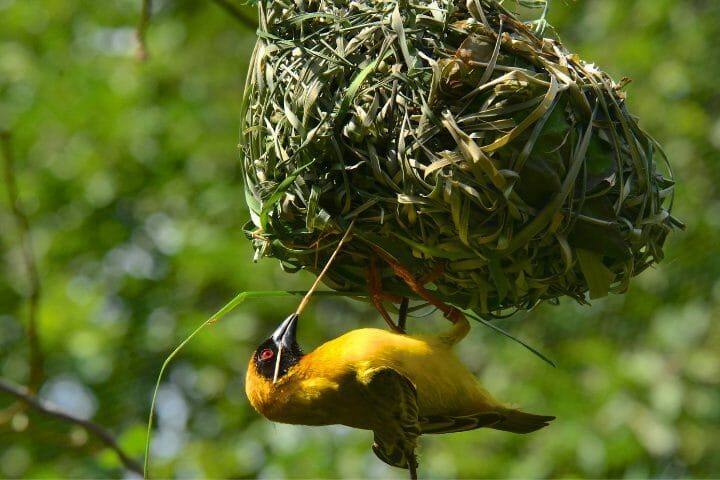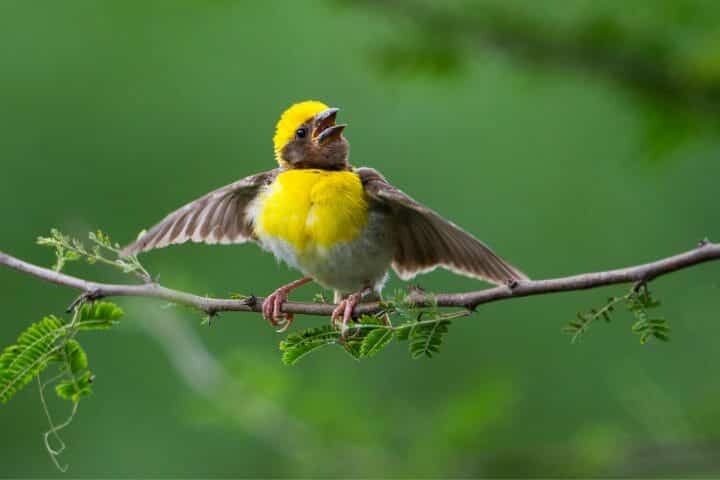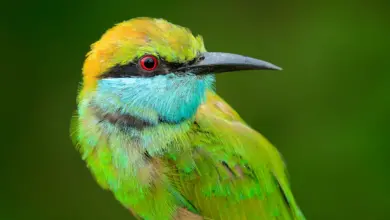What Makes A Weaver Bird So Interesting? Weaver Bird Facts
Weavers, as the name suggests, are master nest makers, using the art of weaving with their beaks. But that’s not all! Here’s what makes a weaver bird so interesting
The weaver bird is famous for its beautiful nests and ability to tie knots (which is why it’s called a weaver). Weavers are also known for their sociable nature, a rarity in the bird kingdom.
In this article, we will discuss why the weaver bird is so attractive.
We will look into their nesting habits, the variation in nests built by different species of weavers, and how they live and raise their little ones.

What Is Special About the Weaver Bird?
Weaver birds are the only birds that can tie knots! These birds use this ability to weave their nests. Weavers are small finch-like birds with a body that’s about 4.5 to 10 inches long.
Their nests are a subject of great fascination and research, particularly the ones built by the sociable weaver birds.
These birds build some of the largest nests in the bird kingdom. Their nest structure is roofed and has complex woven chambers, with many of them living in the same nest together.
Nest Making
Whether it is the sociable weaver or the baya weavers, their bird nests are impressive structures. Birders call weaver birds natural engineers thanks to their nest-building abilities.
While sociable weavers build some of the biggest communal hanging nests in the world, the baya weavers make some of the most intricately designed nests.

Sociable Weavers
Sociable Weaver birds are a bird species from the weaver family commonly residing in South Africa. They build their nests from stiff and dry grass.
This bird species builds large compound communal nests that can accommodate as many as one hundred birds simultaneously.
Sociable Weavers build their nests on tall objects such as lamposts, streetlights, and acacia trees. These nests are permanent and highly structured.
The nests have a large number of chambers in them. The centrally located chambers are great for the chill nighttime cold in the African desert.
In contrast, those towards the outer edges are cooler and better for the daytime heat.
During the night, the birds roost together in the inner rooms to preserve heat, whereas they spend most of the time in the outer rooms during the day.
Each of the rooms is used by one pair of birds where they roost and breed. Sociable weaver nests often house many generations of the same family, with the offspring choosing to remain in the same nest.
Baya Weavers
Male baya weavers are known for making some of the most elaborate and beautiful hanging nests in the world.
They make these nests with long strips of paddy leaves, rough grasses, and long strips of palm leaves, weaving them together intricately to provide sturdiness to the structure.
The nest itself is shaped like a long cylinder at the entrance, with a bulb-like central chamber for the family to live in. These nests can be 8 to 30 inches long.
The baya weavers are found all across the Indian subcontinent and Southeast Asia. They build their nests above or near the water on palm trees because that way, predators cannot reach the nests.
But perhaps the most important part of these nests is the mating rituals that drive this nest-making.
Female baya weavers choose their male partners based on the quality of the nest – its sturdiness, location, and ability to keep predators at bay.

Sociable Weaver- Family Life
As we shared above, sociable weavers live in huge colonies together. Let’s talk a bit about their family life.
When they lay their eggs, sociable weavers do so in a clutch of 2 to 6 eggs. The parent weavers take turns incubating the eggs. These eggs hatch in about two weeks.
Parent weavers get lots of help with their newly born offspring. The older siblings of the eggs look after their younger siblings by providing food for them.
Parent weavers help others out by providing insects for each other’s hatchlings.
Another interesting fact about these birds is that sociable weavers never migrate.
When the chicks develop wings and learn how to fly, they move from their existing chamber to a new empty chamber in the same nest.
These birds also have a system to keep in touch with these huge communal nests safe from predators.
Weavers maintain constant contact with each other and have a long call signal that tells each other when they are coming and going.
If they see a predator coming, they have a different, short signal for that too.
Intelligence
Weaverbirds are naturally intelligent and weave their nests with lots of effort.
The male baya weaver can take up to 500 trips to build its intricate nest! The female chooses males based on who builds the best nest!
These birds build their nests over palm trees near water to keep them safe from predators.
Sociable weavers are smart enough to spot predators and tell each other about them. Another sign of intelligence is that they always build their nests high up in trees.
Despite their small size, the sociable weavers build large community nests with several rooms. After building them, they protect all fellow residents of the nest.

Brood Parasitism in Some Species
Village weavers sometimes leave their eggs in each other’s nests. However, weavers have developed a mechanism to help identify their eggs from the parasite’s eggs.
Village weaver females figure out and remove the other birds’ eggs from their nests. They have evolved in a way that the patterns of spots on a clutch of eggs are unique and different from those in another one.
In Africa, village weavers have been victims of brood parasitism from the Diederik cuckoo.
Frequently Asked Questions
What is the Behaviour of a weaver bird?
They believe in living in communal nests. The males build these nests together, and then a pair of two weavers occupy each chamber.
What is a weaver bird nest made of?
Baya weavers who live near water use grass strips, leaves (delicate leaf fibers that they weave together), twigs, and roots.
How long do weaver birds live?
Do weaver birds sing?
Wrap Up
Weaver Birds are intelligent and hardworking individuals. They are the only known bird species that can weave, where they get their name.
Weavers use their sharp beaks to cut leaves and grass into fine and thin fibers, which the bird weaves together to make their nests.





